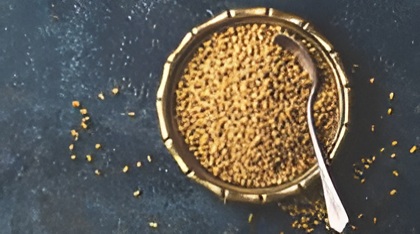
Fenugreek: An Ancient Herb with Modern Benefits
Fenugreek, scientifically known as Trigonella foenum-graecum, is a versatile herb that has been cherished for centuries for its medicinal and culinary uses. Native to regions in the Mediterranean, southern Europe, and western Asia, fenugreek seeds and leaves have become integral in various cuisines and traditional medicine around the world. This article delves into the health benefits, culinary uses, and cultivation of fenugreek, highlighting why it deserves a spot in your kitchen and wellness routine.
Nutritional Profile of Fenugreek
Fenugreek is packed with essential nutrients, making it a powerhouse of health benefits. The seeds contain significant amounts of protein, fiber, vitamins (especially vitamin C and several B vitamins), and minerals such as iron, magnesium, and manganese. The high fiber content in fenugreek helps support digestive health, while the antioxidants contribute to overall well-being. Incorporating fenugreek into your diet can enhance your nutrient intake in a natural way.
Health Benefits of Fenugreek
- Blood Sugar Control: Fenugreek has garnered attention for its potential to help manage blood sugar levels. Studies suggest that fenugreek seeds may improve insulin sensitivity and lower blood sugar levels, making it a beneficial supplement for individuals with diabetes.
- Digestive Aid: The fiber in fenugreek can help alleviate digestive issues such as constipation and bloating. It acts as a natural laxative, promoting regular bowel movements and overall gut health.
- Hormonal Balance: Fenugreek is often used to support hormonal balance, particularly in women. It may help alleviate symptoms associated with menopause and menstruation, such as cramps and mood swings.
- Lactation Support: Fenugreek has a long history of use among nursing mothers to boost milk production. Research indicates that it can enhance breast milk supply due to its galactagogue properties.
- Anti-inflammatory Effects: The compounds found in fenugreek possess anti-inflammatory properties, which can help reduce inflammation in the body. This may be beneficial for conditions like arthritis or other inflammatory disorders.
- Weight Management: Fenugreek may aid in weight loss efforts by promoting a feeling of fullness. Its soluble fiber can slow digestion, helping to curb appetite and reduce overall calorie intake.
Culinary Uses of Fenugreek
Fenugreek is a key ingredient in many global cuisines. Its unique flavor, which is often described as slightly bitter and nutty, adds depth to a variety of dishes. Here are some common culinary uses:
- Spice Blend: Fenugreek seeds are a staple in Indian curry powders and spice blends like panch phoran. They can be used whole or ground, and they impart a warm, aromatic flavor to dishes.
- Cooking with Leaves: Fenugreek leaves, known as “methi,” are used in Indian and Middle Eastern cuisines. They can be cooked in stews, added to breads, or used fresh in salads.
- Baking: Ground fenugreek can be added to bread recipes for a subtle flavor enhancement. It works well in whole grain and artisan breads.
- Pickles and Chutneys: Fenugreek seeds are often included in pickles and chutneys, where their flavor can shine through and complement other ingredients.
How to Use Fenugreek
Incorporating fenugreek into your diet is simple and versatile. Here are some ways to use it:
- Tea: Fenugreek tea can be made by steeping seeds in hot water. This soothing drink can be enjoyed to help with digestion and blood sugar management.
- Sprouts: Fenugreek seeds can be sprouted for added nutrition. The sprouts are crunchy and can be added to salads or sandwiches for a nutritious boost.
- Supplements: Fenugreek is available in capsule or powder form as a dietary supplement. This can be an easy way to incorporate the herb into your routine, especially for those looking for specific health benefits.
Growing Fenugreek
If you’re interested in growing your own fenugreek, you’ll be pleased to know that it’s easy to cultivate. Here’s a quick guide:
- Location: Fenugreek prefers warm weather and full sunlight. Choose a sunny spot in your garden or a container on your balcony.
- Soil: Use well-draining soil enriched with organic matter. Fenugreek thrives in fertile soil with a pH of 6.5 to 7.5.
- Sowing Seeds: Sow seeds directly into the soil, about 1 inch apart. Water gently to keep the soil moist, but not soggy.
- Harvesting: Fenugreek leaves can be harvested within a few weeks, while seeds take about three months to mature. Once the pods turn brown, they can be harvested and stored.
Precautions and Side Effects
While fenugreek is generally considered safe for most people, it’s important to use it in moderation. Gas or bloating are examples of intestinal pain that some people may have. Those with allergies to chickpeas or other legumes should exercise caution. Pregnant women should consult a healthcare professional before using fenugreek, as it may stimulate uterine contractions.
Conclusion
Fenugreek is more than just a culinary herb; it’s a multifaceted plant that offers a wealth of health benefits. From its ability to manage blood sugar to its role in digestive health, fenugreek deserves recognition in both the kitchen and the medicine cabinet. Whether you choose to sprinkle it on your dishes, brew it as tea, or grow it in your garden, incorporating fenugreek into your lifestyle can enhance your overall health. Embrace this ancient herb and unlock its potential in your daily routine.